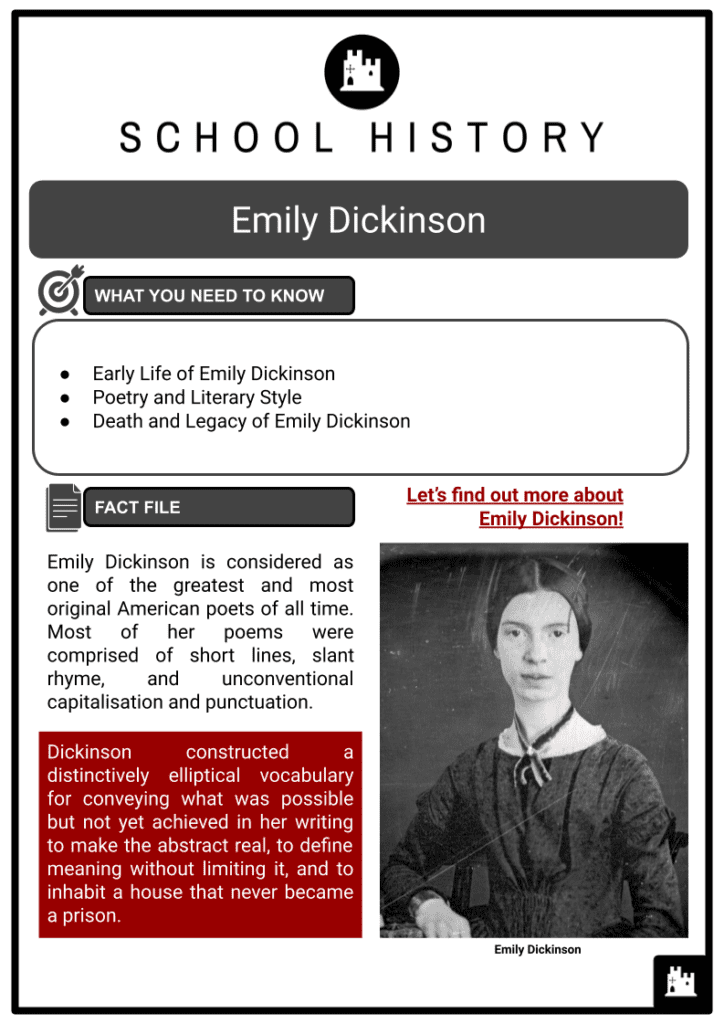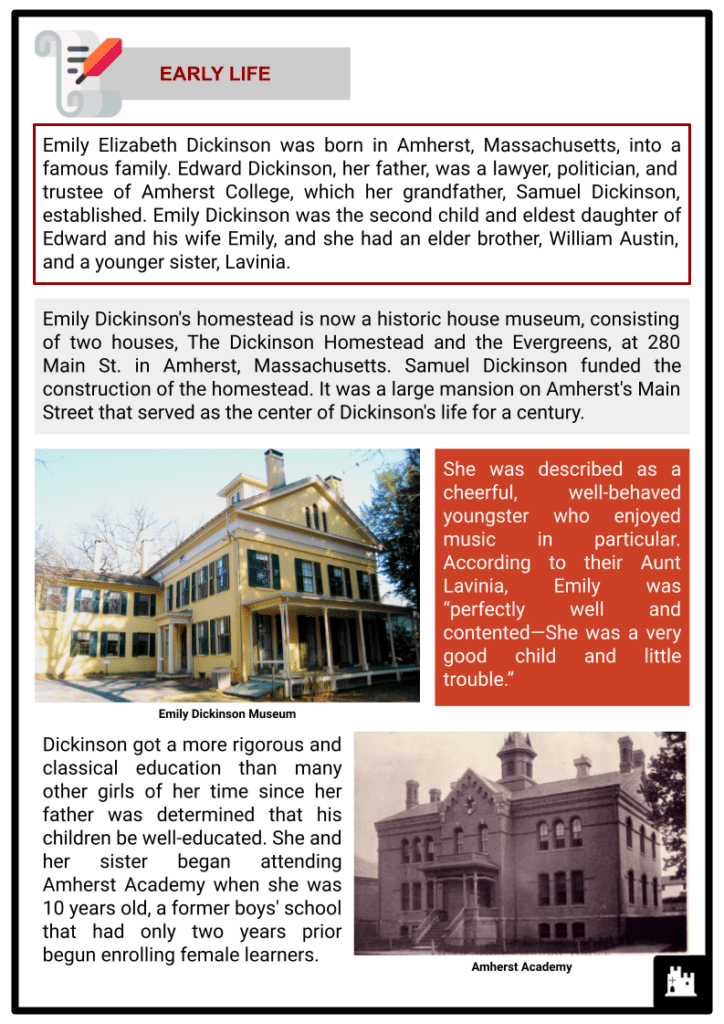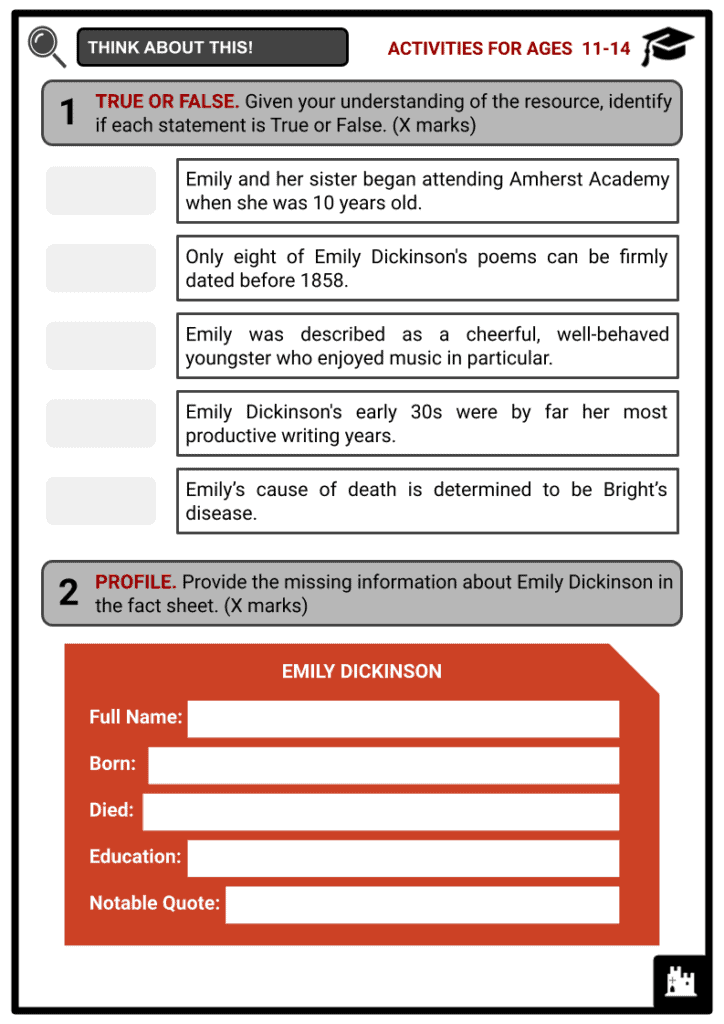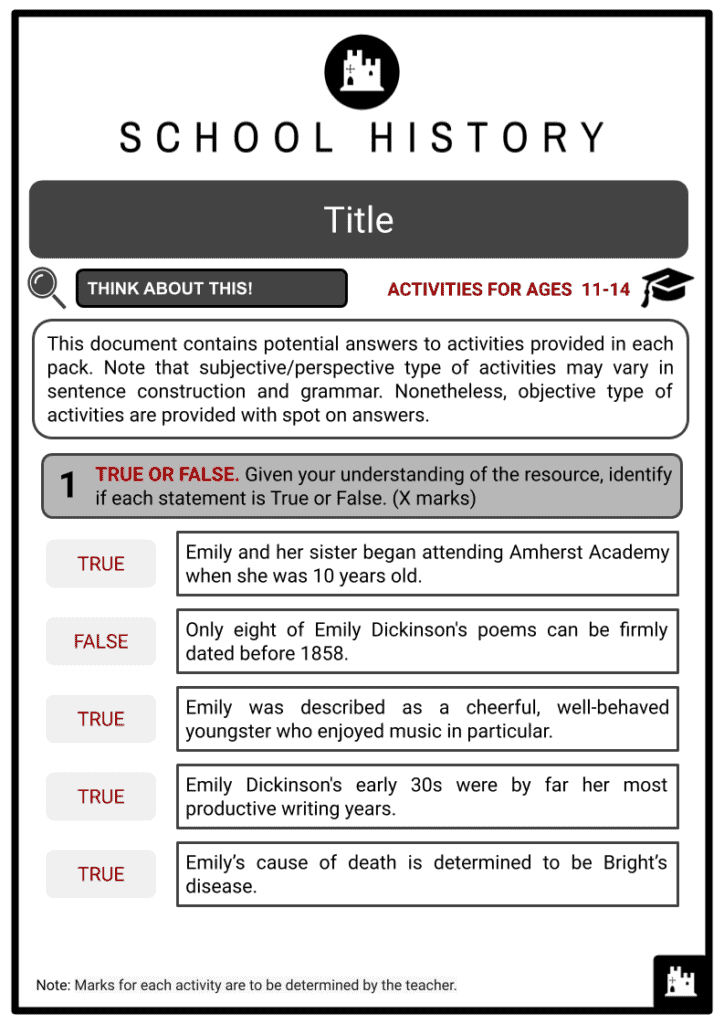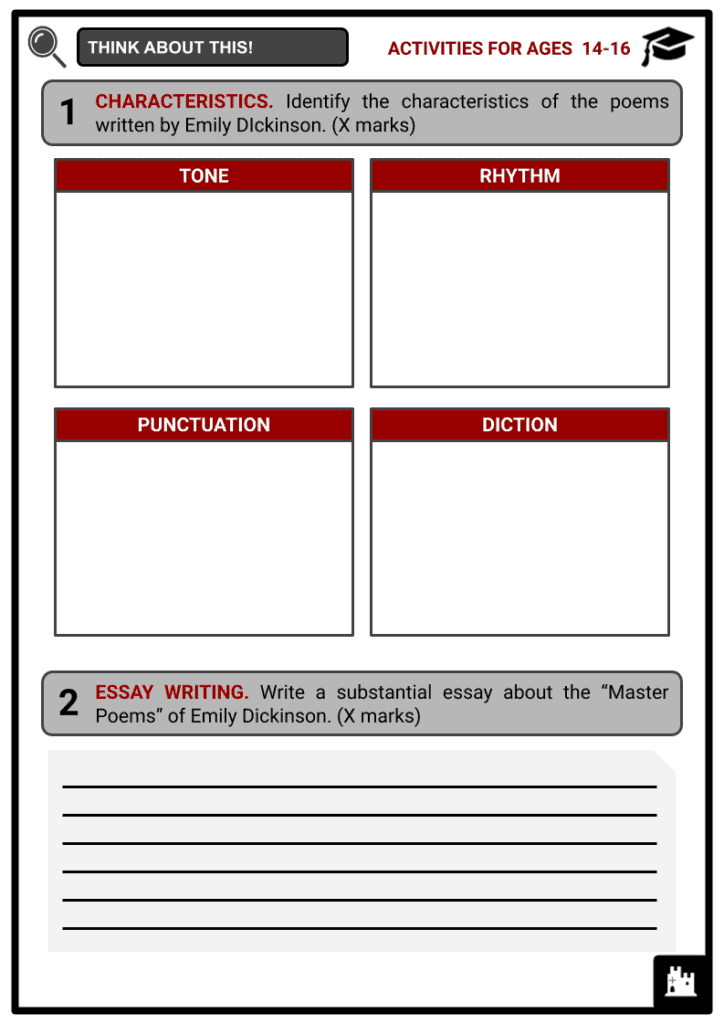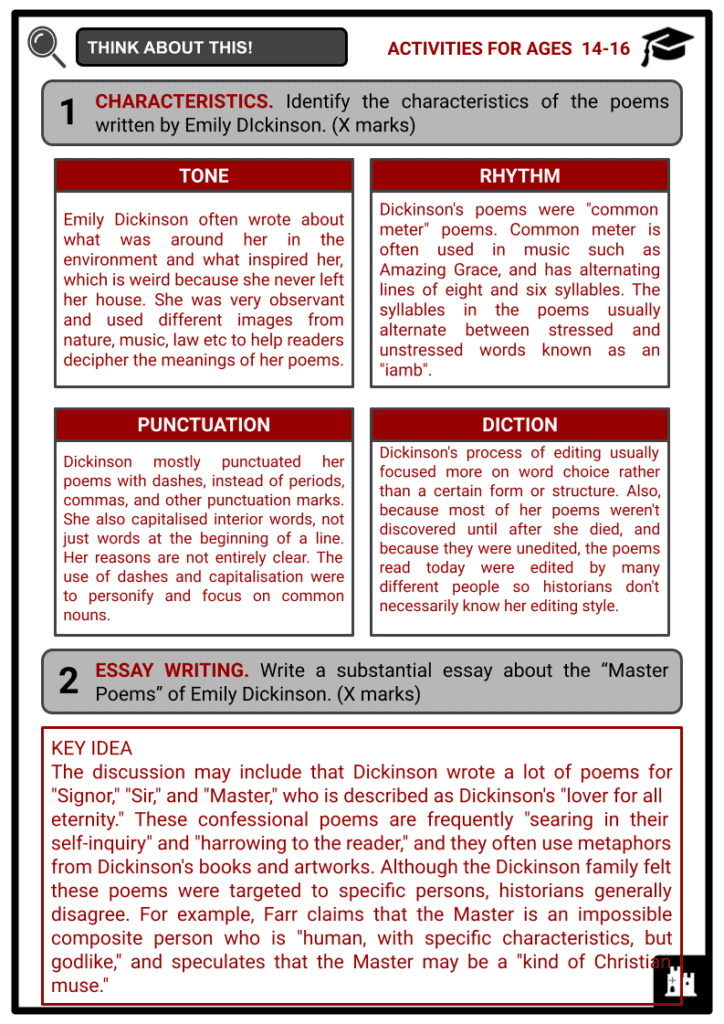Download Emily Dickinson
Do you want to save dozens of hours in time? Get your evenings and weekends back? Be able to teach about Emily Dickinson to your students?
Our worksheet bundle includes a fact file and printable worksheets and student activities. Perfect for both the classroom and homeschooling!
Table of Contents
Add a header to begin generating the table of contents
Summary
- Early Life of Emily Dickinson
- Poetry and Literary Style
- Death and Legacy of Emily Dickinson
Key Facts And Information
Let’s find out more about Emily Dickinson!
- Emily Dickinson is considered as one of the greatest and most original American poets of all time. Most of her poems were comprised of short lines, slant rhyme, and unconventional capitalisation and punctuation.
- Dickinson constructed a distinctively elliptical vocabulary for conveying what was possible but not yet achieved in her writing to make the abstract real, to define meaning without limiting it, and to inhabit a house that never became a prison.
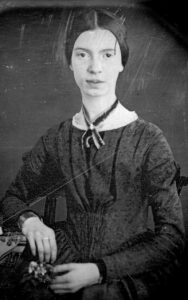
Early Life
- Emily Elizabeth Dickinson was born in Amherst, Massachusetts, into a famous family. Edward Dickinson, her father, was a lawyer, politician, and trustee of Amherst College, which her grandfather, Samuel Dickinson, established. Emily Dickinson was the second child and eldest daughter of Edward and his wife Emily, and she had an elder brother, William Austin, and a younger sister, Lavinia.
- Emily Dickinson's homestead is now a historic house museum, consisting of two houses, The Dickinson Homestead and the Evergreens, at 280 Main St. in Amherst, Massachusetts. Samuel Dickinson funded the construction of the homestead. It was a large mansion on Amherst's Main Street that served as the center of Dickinson's life for a century.
- She was described as a cheerful, well-behaved youngster who enjoyed music in particular. According to their Aunt Lavinia, Emily was “perfectly well and contented—She was a very good child and little trouble.”
- Dickinson got a more rigorous and classical education than many other girls of her time since her father was determined that his children be well-educated. She and her sister began attending Amherst Academy when she was 10 years old, a former boys' school that had only two years prior begun enrolling female learners.
- Dickinson continued to thrive in her studies, despite the fact that they were difficult and demanding, and studied literature, science, history, philosophy, and Latin. She did have to miss school on occasion because of recurring illnesses.
- Emily Dickinson's interest with death developed at an early age as well. Her first great loss occurred when she was fourteen years old, when her cousin and friend Sophia Holland died of typhus. Holland's death pushed her into such a depressed state that she was transferred to Boston for treatment.
- Following her recovery, she returned to Amherst, where she continued her studies alongside some of the individuals who would become lifelong friends, including Susan Huntington Gilbert, her future sister-in-law.
- Dickinson went to Mount Holyoke Female Seminary after finishing her studies at Amherst Academy. Her family wanted her to come home; she despised the strong, evangelical religious environment, she felt lonely, and she didn't enjoy the teaching approach, to name a few reasons for her early departure. In any case, by the time she was 18 years old, she had returned home.
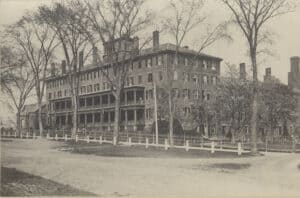
Poetry and Literary Styles
- It's unknown when Dickinson began composing her poems, but it's reasonable to presume she was writing on them for a long period before they were ever revealed to the public. Only five of Emily Dickinson's poems can be firmly dated before 1858, according to Thomas H. Johnson, the editor of ‘The Poems of Emily Dickinson’. Her poetry of the time was characterised by a strict adherence to the conventions of the day.
- Two of her first five poems are sarcastic, written in the form of funny, "mock" valentine poetry with intentionally flowery and overblown language. Two more of them have a more melancholic tone to them, which she is known for. One is about her brother Austin and how much she missed him, while the other was composed for Gilbert and is a lament about the grief of dreading the loss of friendship. Its opening line is: "I have a Bird in Spring."
- Between 1858 and 1868, the Springfield Republican published a handful of Dickinson's poetry; she was friends with the editor, journalist Samuel Bowles, and his wife Mary.
- All of the poems were anonymously published and substantially altered, with most of Dickinson's signature stylisation, syntax, and punctuation removed.
- Dickinson began collecting her poems in 1858, even as she wrote more.
- The first poem published, "Nobody knows this little rose," may have been released without Dickinson's consent, while another poem, "Safe in their Alabaster Chambers," was retitled and published as "The Sleeping."
- She reviewed and made fresh copies of her poetry, putting together manuscript books.
- Between 1858 and 1865, she produced 40 manuscripts, comprising just under 800 poems.
- Dickinson also composed a trio of letters known as the "Master Letters" during this same period, but they were never sent and were discovered as drafts among her archives. They are poetry in a peculiar way that has evaded even the most learned of scholars, addressed to an unnamed guy she simply calls "Master." They may not have been meant for a real person at all, and they remain one of Dickinson's life's great mysteries.
- Dickinson's early 30s were by far her most productive writing years. She withdrew almost entirely from society and interactions with locals and neighbours, and instead focused on writing more and more.
- Her poems from this time period became the gold standard for her creative efforts in the end. With strange and particular grammar, line breaks, and punctuation, she formed her own writing style. It was during this time that the themes of mortality, for which she was well known, began to surface more frequently in her writings. While her earlier works had occasionally touched on themes of grief, fear, or loss, it wasn’t until this most prolific era that she fully leaned into the themes that would define her work and her legacy.
- Dickinson is said to have written around 700 poems between 1861 and 1865. She also communicated with Thomas Wentworth Higginson, a literary critic who became a close friend and longtime correspondent. Dickinson's work at the time seemed to embrace dramatisation as well as genuinely felt and sincere sentiments and insights.
- Dickinson's output began to decrease by about 1866. Her faithful home helper got married and left her household in 1866, and she had endured personal losses, including the death of her pet dog Carlo. According to most estimates, she completed around a third of her body of work after 1866.
- Dickinson's reclusive inclinations were increasingly extreme around 1867. She started refusing to see visitors, only communicating to them behind a door, and she only stepped out in public on rare occasions. Despite her reluctance to physical interaction, Dickinson was a prolific correspondent; almost two-thirds of her surviving correspondence was written between 1866 and her death, 20 years later.
- Dickinson's personal life was very complex at the time.
- In 1874, her father died of a stroke, but she refused to leave her self-imposed isolation for his memorial or funeral.
- She may have also had a brief romantic relationship with Otis Phillips Lord, a judge and widower who had been a lifelong friend.
- Although only a small portion of their correspondence exists, it demonstrates that they wrote to each other on Sundays like clockwork, and their letters were filled with literary references and quotes.
- Dickinson's former tutor, Charles Wadsworth, died in 1884, two years after Lord died following a long illness.
- Even a quick review of Dickinson's poems exposes some of her style's hallmarks. Dickinson used unusual punctuation, capitalisation, and line breaks, which she said were essential to the message of the poetry. When her early poems were modified for publication, she was furious, claiming that the changes to the stylisation had changed the entire meaning of the piece.
- Her meter is particularly unusual, since she ignores the mainstream pentameter in favour of tetrameter or trimeter, and even then, she uses meter irregularly within a poem. Her poetry, on the other hand, followed some standards, such as the usage of ballad stanza forms and ABCB rhyme schemes.
- Dickinson's poetry covers a wide range of topics. Her fixation with mortality and death is arguably best reflected in one of her most famous poems, "Because I did not stop for Death."
- In certain cases, this extended to her highly Christian themes, with poetry related to the Christian Gospels and the life of Jesus Christ. Although her death poems are often spiritual in tone, she also has a remarkably vivid array of portrayals of death by diverse, often brutal, ways.
- Dickinson's poetry, on the other hand, frequently uses comedy, sarcasm, and irony to make her point; she isn't the gloomy character she is generally represented as due to her morbid topics. Many of her poems use garden and floral imagery, reflecting her lifelong love of meticulous gardening and frequently employing the "language of flowers" to represent topics like youth, prudence, and even poetry itself. Nature's imagery appeared as living animals on occasion, like in her famous poem, "Hope is the thing with feathers."
Death and Legacy
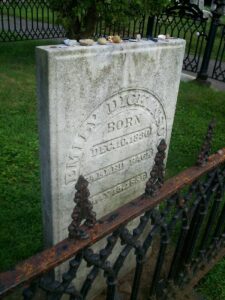
- Dickinson is said to have continued composing until nearly the end of her life, although her loss of stamina was evident when she stopped editing and organising her poetry. When her brother's marriage to her beloved Susan fell apart, her brother Austin turned to a mistress, Mabel Loomis Todd, whom Dickinson had never met. Her beloved nephew died in 1883, and her mother died in 1882.
- Her health deteriorated during 1885, and her family became more anxious. In May of 1886, Dickinson grew unwell and died on May 15, 1886. Bright's disease, a kidney ailment, was determined to be the cause of death by her doctor. Susan Gilbert was given the task of preparing her corpse for burial and writing her obituary, which she accomplished meticulously. Dickinson was laid to rest in her family's grave in Amherst West Cemetery.
Image sources
- https://upload.wikimedia.org/wikipedia/commons/e/eb/Seminary_Building%2C_Mount_Holyoke_Female_Seminary%2C_1886.jpg
- https://www.emilydickinsonmuseum.org/wp-content/uploads/Theme-Images/daguerreotype-cropped-corrected-1.jpg
- https://en.wikipedia.org/wiki/Emily_Dickinson#/media/File:EmilyDickinsonGrave-color.jpg

